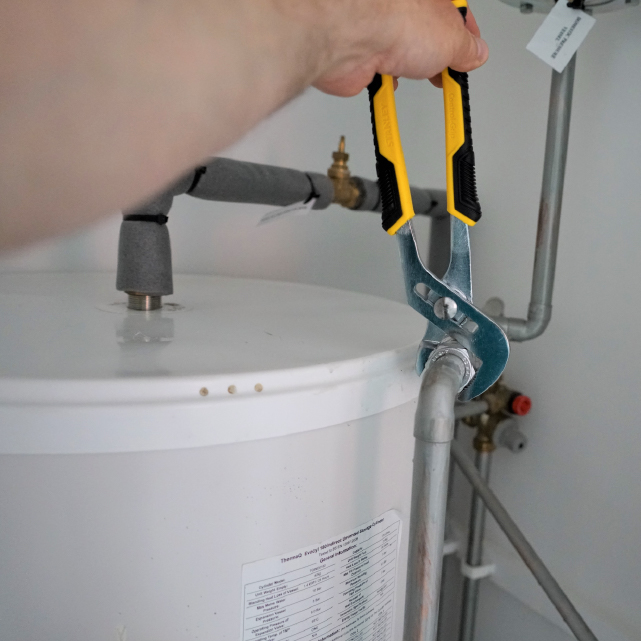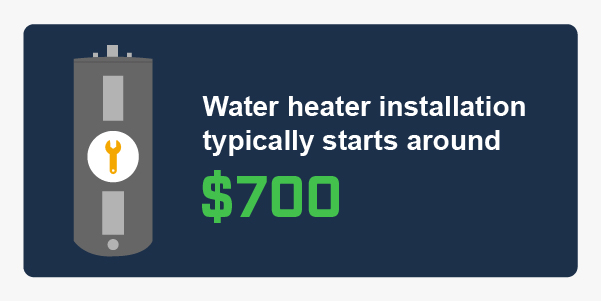
Most modern water heaters are designed to last for years but will start to show signs of decline after 8-15 years. Over time, minerals can build up in the unit, and parts can begin to corrode or break down from use. As that happens, efficiency decreases and unit failure can occur.
It’s essential to keep an eye out for indications your water heater is nearing the end of its life. Property owners never want to have their commercial HVAC systems break down, so paying attention to your water heater can save you an emergency call later down the road. Some signs you will likely notice when your unit is starting to decline are:
- Rust-colored hot water coming out of the hot water faucet
- Metallic smell or taste from the hot water
- Signs of leaking or puddles collecting at the base of the unit
- Odd sounds like loud pops or cracks
You can also perform a quick internal check if you are concerned about the function of your water heater. Attach a hose to the drain, turn off the water heater, and allow it to drain. Look for evidence of sediment or murky water. If you see those signs, it’s a good indication your unit is on its way out.
 Steps for a Water Heating Installation
Steps for a Water Heating Installation
Installing a water heater can be a lengthy process, but it’s not impossible to replace one on your own. These steps are how most water heaters are installed:
- Shut off the water and gas or electricity: The first step is to turn off utilities to the unit. For an electric water heater, shut off the circuit breaker. For gas water heaters, use the shutoff valve on the gas supply closest to the water heater.
- Drain the water heater tank: Attach a hose to the drain valve near the bottom of the water heater and open the drain valve slowly so that sediment does not clog the drain valve. Let the tank drain completely.
- Disconnect all the water lines: Next, you’ll want to disconnect the hot and cold water lines from the water heater unit.
- Disconnect the gas or electrical lines: After that, it’s time to disconnect the power source from the water heater. You’ll want to confirm the circuit is completely off for electric water heaters by using a non-contact voltage tester.
- Disconnect the water heater vent (Gas heaters only): For gas water heaters, you’ll need to unscrew the vent pipe from the draft hood at the top of the unit. If it is still in good shape you can likely use it for your new water heater.
- Remove the old water heater and replace it with the new one: Clean the area under the old water heater if needed and put the new heater in place, lining it up with the proper plumbing connections. If the water heater isn’t level, use shims to level it out.
- Repeat the above steps in reverse to install your new water heater.
- Complete water heater installation: Turn on a hot water tap at a remote location in the house, then turn on the cold water supply valve to the water heater and let the tank fill with water. You’ll know the tank is full when water begins to flow at the hot water tap. Turn on utilities and set the temperature
Generally, it is recommended that you let professionals handle all aspects of commercial HVAC installation. They come equipped with all the necessary tools and can instantly troubleshoot any issues. Plus, they will ensure the unit is appropriately sized and installed correctly and can take the old unit off your hands and dispose of it safely.
What is the Cost of New Water Heaters?
Commercial water heater prices vary significantly. Size is one factor in determining the cost. However, other elements, such as the capacity for producing heat, voltage, heating type, and manufacturer warranty coverage requirements.
Some installation costs can start around $700 and reach $2,000 or more. Those costs will be higher if you are looking to install a tankless water heater. However, tankless systems are highly energy efficient and can drastically reduce water heating costs—as much as 20% in monthly savings. Keep in mind that tankless water heaters must be installed by a professional.
Proper Water Heater Installation
If your commercial property requires a new water heater, it’s time to learn about replacement. It is possible to remove the old unit and install a new one yourself, as long as you are up for the challenge. Before purchasing a new water heater, you must first figure out what type of unit you have—gas or electric. Then determine the size. Residential units often come in 30, 40, or 50-gallon types. Commercial water heaters can be much larger—from 100 gallons to 11,000 gallons or more.
If you notice that your hot water output has been lacking in general, you might want to consider increasing in size. However, you will need to ensure you have enough space and that components like the flue and gas line will work with your new water heater.
Pro Tip for Proper Sizing: Not all commercial properties are created equal and have different heating and cooling needs. Consult with your Beaverton HVAC contractors and have them perform a proper sizing analysis. A correctly sized unit can save energy costs while providing perfect hot water, heating, and cooling.
Let AAA Heating and Cooling Handle Your Water Heater Needs
At AAA Heating and Cooling, we have partnered with Beaverton professionals for over 50 years. Whether you are looking for a new water heater, energy-efficient HVAC models, or routine maintenance, we are here for you.
Call us today and schedule an appointment.
